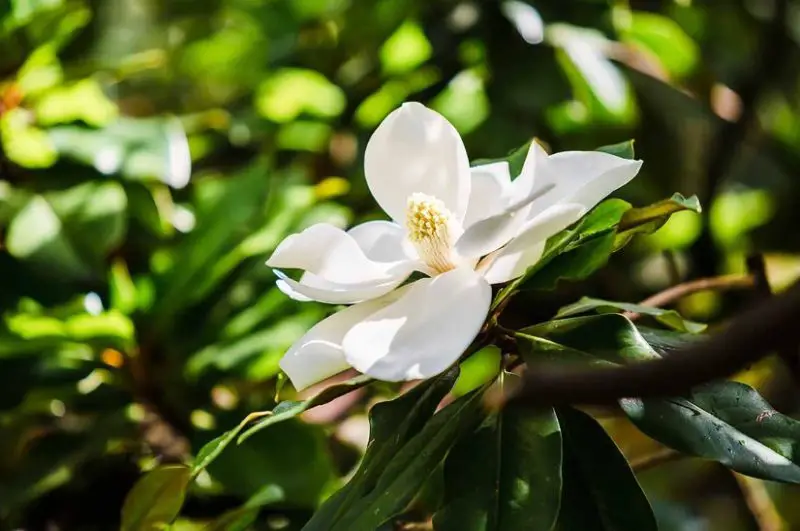Magnolia trees are among the most stunning additions to any landscape, boasting large, fragrant flowers and majestic branch structures. As one of the oldest flowering plants on Earth, magnolias come in a variety of sizes and types, from towering shade trees to compact shrubs.
Whether you’re growing a southern magnolia (Magnolia grandiflora) or a smaller cultivar, learning how to plant, grow, and care for magnolias will reward you with beautiful blooms and lush greenery for years to come.
About Magnolias

Magnolias aren’t just native to the American South. In fact, the genus Magnolia includes hundreds of species that vary in size, shape, and growing requirements. Deciduous or evergreen, large or small, there’s a magnolia for every garden. These trees have been thriving for millions of years, predating even bees, which explains why they are primarily pollinated by beetles.
Some magnolia species are cold-hardy, able to survive in zones as low as zone 4, while others thrive in the warm, humid climates of the American South. The southern magnolia is one of the largest in the family, growing up to 80 feet tall with leaves a foot long. Its dinner-plate-sized flowers are famous for their delightful fragrance.
Different Magnolia Types
Magnolias come in many forms that fit different landscaping needs:
- Shade trees: For large spaces that need towering structures.
- Flowering shrubs: Perfect for borders and hedges.
- Privacy screens: Dense foliage provides a natural barrier.
- Container-friendly varieties: For smaller gardens or patios.
When choosing a magnolia tree, it’s essential to consider the flowering time, hardiness zone, color, and mature size. Picking the right variety for your climate and space will ensure long-term success in growing these magnificent plants.
How to Plant Magnolia Trees
When to Plant Magnolias
Magnolia trees can be planted in either spring or fall. If you’re planting in the fall, ensure you do so about 4-6 weeks before the first frost, giving the tree enough time to establish its roots. Bare root stock, often available in the spring, should be planted as soon as you receive it.
Where to Plant Magnolias
Choosing the right location is crucial for magnolia growth. Most species prefer full sun to light shade, but in hotter climates, they require protection from the harsh afternoon sun. Magnolias also have shallow root systems, so keep them away from building foundations, sidewalks, and driveways.
- Sun exposure: Full to partial sun with some afternoon shade in hot climates.
- Soil: Moist but well-drained, slightly acidic soil (pH 5.5-6.5) is ideal.
- Space: Keep in mind the mature size of your tree or shrub. Some magnolias grow large, so choose a site that offers ample room for growth.
Steps for Planting Magnolias
- Prepare the planting site: Remove all sod and weeds from a spot twice the size of the hole you plan to dig.
- Dig the hole: Ensure it is as deep as the root ball but twice as wide. The hole should have sloping sides to help with root establishment.
- Loosen the soil: Both on the sides and bottom of the hole. Compact soil can hinder root growth.
- Test fit the tree: Place the magnolia in the hole, ensuring the root ball is level with the soil surface. For grafted magnolias, the graft union should sit above the soil.
- Backfill and water: Refill the hole halfway, tamp down the soil, and water it well. Continue filling the soil around the roots and give it another deep watering.
- Mulch: Spread mulch about 3-4 inches thick around the tree, extending 2-3 feet from the trunk. Keep the mulch away from the trunk itself.
How to Care for Magnolia Trees
Watering and Fertilizing
Newly planted magnolias need regular watering to establish strong roots. Water them several times a week during the first few months, then switch to weekly watering as the tree matures.
Magnolias don’t typically require fertilizing, but for faster growth in the first few years, apply a balanced fertilizer (10-10-10) in the spring. Be cautious not to over-fertilize, as this can stress the tree.
Pruning Magnolias
Pruning magnolias should be done with care. Young trees may benefit from light shaping, but mature trees should not undergo heavy pruning, as their wounds heal slowly.
- Prune after flowering: This allows the tree to maintain its natural shape and avoids cutting off future blooms.
- Remove damaged branches: Do this as soon as you notice them to prevent disease or pests.
Propagating Magnolias
Magnolias can be propagated by seed or cuttings, but cuttings are typically more successful. Seed-grown magnolias may take over a decade to bloom, while cuttings usually bloom in just a few years. Here’s how to propagate via cuttings:
- Take cuttings: In mid to late summer, select firm but still pliable branches. They should be 6-8 inches long.
- Prepare the cuttings: Remove all but the top two leaves, and lightly scratch the base of the cutting to expose fresh tissue.
- Apply rooting hormone: Use a strong rooting hormone (8-10,000 ppm) to encourage root growth.
- Plant in moist media: Use a mix of coir and perlite or just perlite. Keep the cuttings under a plastic dome to maintain high humidity.
- Use bottom heat: A heat mat set to 75-80℉ will promote faster rooting, which can take 5 to 10 weeks.
Common Magnolia Pests and Diseases
Although generally resilient, magnolias can sometimes fall victim to pests and diseases:
- Powdery mildew: A fungal disease that can cause white spots on leaves.
- Sooty mold: A black fungus that grows on honeydew excreted by pests like aphids.
To prevent and manage these issues, practice good garden hygiene, such as clearing away fallen leaves and keeping the tree healthy with proper watering and fertilizing.
Best Magnolia Varieties for Different Needs
Magnolias come in many shapes and sizes, suitable for different climates and spaces. Here are a few top choices:
- ‘Little Gem’ (Magnolia grandiflora): A smaller version of the southern magnolia, ideal for compact gardens. It grows to about 15 feet tall.
- ‘Centennial’ (Magnolia stellata): Known for its cold hardiness, this star magnolia produces slightly pink, fragrant blooms.
- ‘San Jose’ (Magnolia x soulangeana): A saucer magnolia with deep magenta flowers, perfect for containers.
Interesting Facts About Magnolias
- Ancient origins: Magnolias have been around for 100 million years and are pollinated by beetles, as they evolved before bees.
- Litter drop: Some magnolias shed their large leaves and fruits, which can create litter. Planting them in areas where this won’t cause a problem is a good idea.
- State flowers: The magnolia is the state flower of Louisiana and Mississippi.
Conclusion
Magnolia trees are a beautiful, ancient addition to any garden, providing shade, flowers, and fragrance. Whether you opt for towering southern magnolia or a compact star magnolia, following proper planting, watering, and pruning techniques will ensure your tree thrives. With the right care, your magnolia will reward you with spectacular blooms and lush foliage year after year.
Start planting a magnolia today and enjoy the timeless beauty of this magnificent tree!






